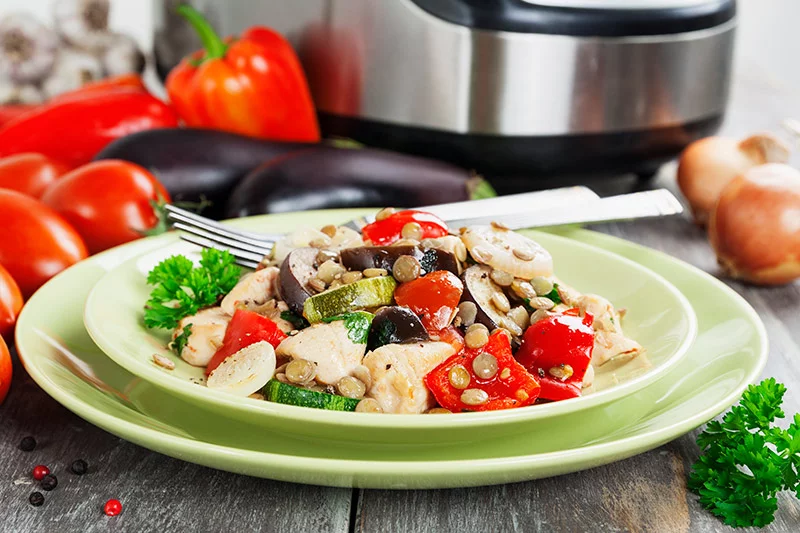
For a straightforward, intuitive way to maintain a balanced diet, look no further than the MyPlate model developed by the United States Department of Agriculture (USDA).
MyPlate provides an easy visual for how much to eat from each food group. A standard-sized dinner plate is divided into three sections: half of the plate is filled with fruits and vegetables, one quarter with complex carbohydrates, and the final quarter with protein-dense whole foods.
“MyPlate is essentially what replaced that dreaded nutrition pyramid,” said Skylar Weir, a clinical dietitian at UCHealth Yampa Valley Medical Center. “It lends itself to a more intuitive eating style because it doesn’t involve counting grams of carbohydrates or protein. It allows people to survey what’s on their plate and recognize, ‘Do I have enough of those fiber-rich fruits and veggies? Is there enough protein?’”
Here’s how the MyPlate model works:
Fill half your plate with colorful foods for optimal organ health
Fill half of your plate at every meal with non-starchy vegetables or fruits, such as broccoli, spinach, tomatoes, cucumbers, berries, apples – the options are endless. Since some people have an aversion to vegetables, Weir likes to refer to this food group as the “colorful foods.”
“These are your fiber-rich foods that help fuel your gut microbiome, they help regulate your cholesterol levels, they’re rich in antioxidants, which help control inflammation in our bodies, and they contain key vitamins and minerals,” Weir said.
People are often surprised to learn just how much of their plates should be taken up by these foods.
“A lot of people nail the meat and potato aspect, but maybe they’re only enjoying a couple of green beans alongside it,” Weir said. “It’s an ah-ha moment to realize the non-starchy, colorful vegetables and fruits are more the star of the show.”
Don’t forget the complex carbohydrates for energy
A quarter of the plate should contain complex carbohydrates such as sweet potatoes, rolled oats, brown rice and other whole grains.
“These are our bodies’ energizers, where we’re pulling our energy from,” Weir said. “They’re essential to maintaining energy throughout the day.”
Add whole-food proteins to protect your body’s building blocks
The other quarter of the plate should come from whole-food sources of protein, such as red meat, chicken, fish, eggs, and legumes such as beans or tofu.
“This is where we’re getting most of the building blocks for the structures of our bodies – our muscles, skin, hair and nails,” Weir said.
Protein is also needed to build a strong immune system. Since it’s slower to digest, it helps stabilize the blood sugar response and helps people feel full.
One serving of healthy fats has its benefits
Finally, add a serving of healthy fats, such as olive oil, avocados, nuts and seeds, to every meal.
“These plant-based healthy fats help our bodies absorb nutrients and provide satiation while also supporting our cardiovascular and hormone health,” Weir said.

The new tool is easy to personalize
If soup or a casserole is on the menu, consider how much of each type of food it contains, then supplement as needed. For instance, if your chicken, rice and broccoli casserole isn’t chock-full of broccoli, you might have a side salad with the meal.
The tool is easily personalized to someone’s cultural needs and food preferences. “If rice and beans are part of your regular diets, those foods absolutely fit in,” Weir said. “It’s just recognizing what else we can add to that meal to make it more well-rounded, balanced and optimal for our health.”
A simpler way to boost nutrition and feel better
Incorporating all elements of a balanced diet can lead to quick wins. For instance, by adding berries and nuts to a bowl of oatmeal, people not only increase the nutrition density, but they often feel full for longer.
“Some feedback I’ll hear is, ‘I’m actually feeling more energized throughout the day. I didn’t realize I was missing out on all these wonderful antioxidants from foods like berries,’” Weir said. “Or, ‘I feel like fiber is helping support my digestion.’”
Best of all, MyPlate can be an easy way to boost nutrition.
“It’s very approachable for people. It’s a non-intimidating way to survey what a healthy and balanced diet is, and how to go about doing that practically,” Weir said. “Eating can carry so much emotion for people – this tries to make it more dynamic and flexible.”
This story first appeared in the Steamboat Pilot.
